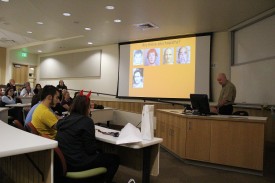Features Reporter
To kick off his Halloween lecture on psychopaths, local clinical psychologist Dr. Bruce Bishop posed this question to his audience: “How many psychopaths does it take to screw in a lightbulb?”
The answer, revealed at the end of the lecture, is this: “Just one. But he or she may manipulate and intimidate you into doing it, and the lightbulb may not be the only one getting screwed!”
These humorous words of caution set the tone for the former CMU teacher’s lecture, which was hosted by Colorado Mesa’s Psychology Club.
“A big chunk of the population is predatory and doesn’t have a conscience,” Bishop said. He was speaking of the estimated 1.5 to four percent of Americans who are likely to be clinical psychopaths.
“You can spot them,” Bishop said.
Psychopathy is a personality disorder that was introduced to contemporary psychology by Hervey Cleckley in 1941. Psychopaths, who can be diagnosed with either the Hare Psychopathy Checklist or the Psychopathic Personality Inventory, are clinically described with terms like fearless dominance, coldheartedness, cunning, parasitic, and callous. These personalities can be manifested as deft, ruthless social manipulators, vicious murderers or anywhere in between.
While outlining the mental condition’s definition, Bishop compared the traits of psychopathy to various high-profile criminals and fictional characters. He recalled the wisdom of his former mentor, Robert Titley, who, in lectures on psychopathy, had suggested that James Bond exhibits classic psychopathic behavior.
Indeed, the checklist for clinical psychopathy syncs pretty cleanly with the super-spy’s personality: superficial charm, grandiose sense of self worth, lack of remorse or guilt and sexual promiscuity.
Even beloved Peanuts pooch Snoopy was branded as a psychopath by Titley.
Despite the horrifying stories of media-spotlighted psychopaths like Charles Manson, Bishop argued that most psychopaths are invisible and that their ability to camouflage makes them that much more sinister.
“Every one of you will, at some point, [encounter a psychopath],” Bishop said.
Bishop also delineated psychopathy from other mental conditions such as Antisocial Personality Disorder, Borderline Personality Disorder and sociopathy.
Bishop concluded his lecture with clips from AMC drama “Breaking Bad” and 1996 crime-comedy “Fargo” that included characters he believed had psychopathic traits.
Psychology club vice president Matt Lescroart said that the lecture helped students understand the nature of personality disorders.
“Psychopaths could be anywhere,” Lescroart said. “It’s important to learn about atypical mental disorders. The fringe things.”

Recent Comments